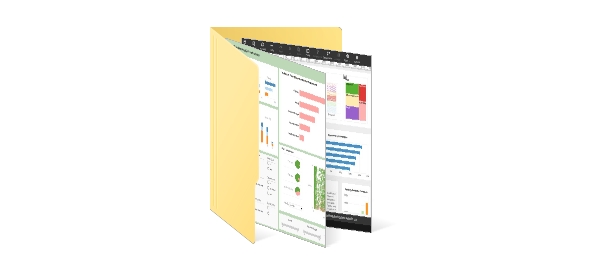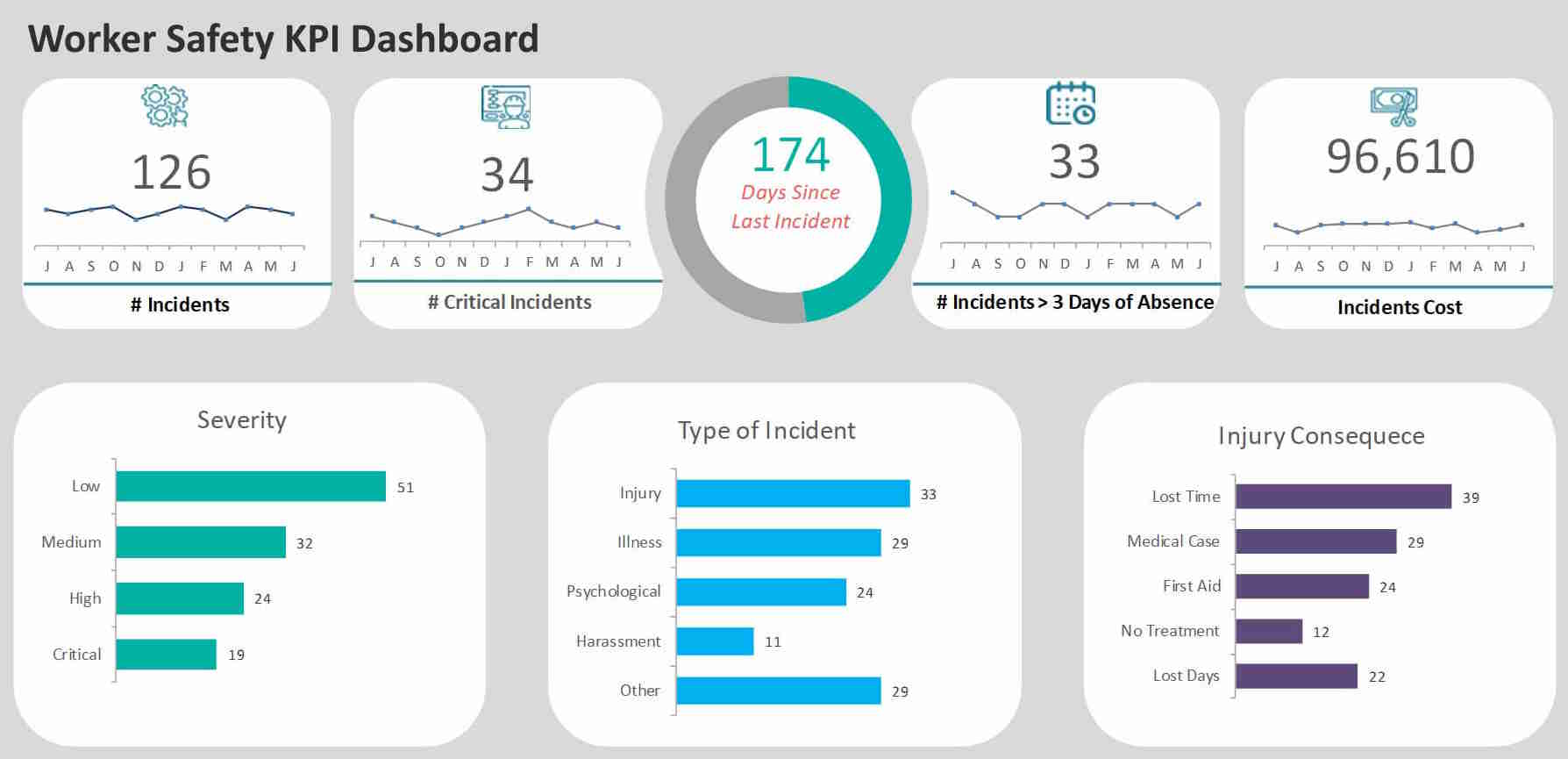What KPIs and Analytics Are Used on a Worker Safety Dashboard?
Organizations are depending more and more on cutting-edge instruments and technology in the field of occupational health and safety in order to track and enhance worker safety. The Worker Safety Dashboard, a centralized center that offers real-time insights into numerous areas of workplace safety, is one such product that is becoming more and more popular.
Analytics and Key Performance Indicators (KPIs) are essential to the effectiveness of these dashboards. Let's examine the particular KPIs and statistics that these dashboards utilize to promote workplace safety.
| #1 Ranking: Read how InetSoft was rated #1 for user adoption in G2's user survey-based index | Read More |
Incident Rate and Severity
KPIs
- Total Incident Rate (TIR): This KPI determines the overall number of occurrences per 100 workers over a certain period of time. It is a basic indicator that gives an overview of a workplace's overall performance in terms of safety.
- Severity Rate: It's critical to evaluate the occurrences' seriousness. The number of days missed as a result of work-related events per 100 full-time workers is measured by the severity rate KPI. This aids businesses in comprehending how occurrences affect the wellbeing and productivity of their personnel.
Analytics
- Incident Trend Analysis: Organizations may find trends in occurrences over time by using trend analysis. This might highlight accident-prone locations, show seasonal fluctuations, and direct preventative actions.
- Root Cause Analysis: It is crucial to investigate the underlying causes of mishaps in order to develop safety solutions that work. In order for companies to conduct focused treatments, analytics technologies may assist in detecting underlying problems.
Near Miss Reporting
KPIs
- Near Miss Rate: Frequency of near misses may be a sign of impending dangers. Monitoring the near miss rate KPI helps to avoid future occurrences and offers information into how effectively safety procedures are doing.
- Reporting Lag Time: It is important to note how long it takes an employee to report a near miss. A more proactive safety culture is indicated by a shorter lag time. Keeping an eye on this KPI guarantees that any risks are dealt with quickly.
Analytics
- Near Miss Analysis: Systemic problems may be found by examining trends and similarities in reported near misses. It enables businesses to act preventively before a comparable incidence worsens and becomes a bigger issue.
- Employee Feedback Analysis: Gaining an understanding of staff input on near misses might provide qualitative information. In order to find reoccurring issues and opportunities for improvement, analytics systems may process and evaluate this input.
Compliance Metrics
KPIs
- Regulatory Compliance Rate: It is crucial to make sure safety laws are followed. This KPI assesses how closely a company complies with federal, state, and local safety regulations.
- Training Compliance: One of the main components of a safe workplace is regular safety training. Ensuring that staff members get sufficient training on safety procedures is done via tracking training compliance KPI.
Analytics
- Audit Trail Analysis: Maintaining compliance requires keeping an audit record of modifications to safety policies and processes. To make sure that safety precautions are routinely taken, analytics tools may examine these traces.
- Training Effectiveness Analysis: It's critical to comprehend the efficacy of safety training programs in addition to compliance. Analytics are able to evaluate the relationship between incident reduction and training completion.
Leading Indicators
KPIs
- Safety Perception Surveys: The way in which workers perceive their safety may be a good sign of future problems. Frequent safety perception surveys provide employers a numerical indicator of how safe they believe their workplace to be.
- Safety Leadership Index: Evaluating safety leadership efficacy is essential. This KPI integrates measures pertaining to communication, dedication to safety, and leadership behavior.
Analytics
- Predictive Analytics: Predictive analytics can anticipate possible safety hazards by using past data. This enables companies to take proactive measures to mitigate risks before they become events.
- Benchmarking Against Industry Standards: Context is provided by comparing safety performance to industry benchmarks. Analytics tools may aid with this benchmarking process and provide an understanding of an organization's position in comparison to its peers.
 |
Learn about the top 10 features of embedded business intelligence. |
Behavior-Based Safety Metrics
KPIs
- Number of Safety Observations: It is crucial to motivate staff members to report and document both safe and risky conduct. Employee adherence to safety procedures may be directly measured by the quantity of safety observations.
- Behavioral Safety Index: The good and negative workplace safety behaviors are measured by this KPI. It offers a comprehensive picture of an organization's safety culture.
Analytics
- Behavioral Trend Analysis: Analyzing patterns in safety observations, akin to incident trend analysis, facilitates the identification of areas that need improvement. It may draw attention to changes in safety culture and guide focused solutions.
- Gamification Analytics: Gamification is a tool used by certain businesses to reward safe conduct. By examining participation rates and their influence on safety measures, analytics tools can monitor the efficacy of gamified safety initiatives.
Emergency Response Metrics
KPIs
- Emergency Response Time: When anything goes wrong, emergency reaction time is crucial. Emergency protocol optimization is aided by tracking the duration of time it takes to launch a response.
- Communication Effectiveness: It is crucial to evaluate the effectiveness of staff communication about emergency information. Metrics like the proportion of workers reached during emergency drills are included in this KPI.
Analytics
- Simulation Analysis: Carrying out emergency reaction exercises is a preventative step. Analytics may evaluate reaction times, communication flow, and general readiness to determine how successful these simulations are.
- Post-Incident Analysis: Analytics tools are essential for analyzing the emergency response after an actual occurrence. This research may identify areas where coordination, communication, and emergency procedure execution need to be improved.
 |
Read the top 10 reasons for selecting InetSoft as your BI partner. |
Ergonomics Metrics
KPIs
- Musculoskeletal Disorder (MSD) Rate: Musculoskeletal ailments may be caused by ergonomic problems. Ergonomics hazards may be identified and mitigated with the use of the MSD rate KPI.
- Ergonomic Assessment Compliance: It is essential that workplace ergonomic evaluations be carried out. The proportion of workstations that get routine ergonomic evaluations is tracked by this KPI.
Analytics
- Ergonomic Risk Analysis: Analytics tools may find trends and similarities in high-risk workplaces by analyzing data from ergonomic examinations. This helps to guide focused efforts aimed at enhancing ergonomics.
- Trend Analysis of MSD Incidents: Through the analysis of trends in events related to musculoskeletal disorders, companies may identify areas that need ergonomic modifications. Proactive ergonomic methods may be developed with the use of this investigation.
Chemical Exposure Metrics
KPIs
- Chemical Exposure Incidents: Monitoring the quantity of chemical exposure episodes is essential for enterprises handling dangerous materials.
- Personal Protective Equipment (PPE) Compliance: It's crucial to make sure workers wear the proper PPE while handling chemicals. The PPE protocol's compliance is gauged by this KPI.
Analytics
- Chemical Exposure Trend Analysis: Analytics can spot trends in cases of chemical exposure, assisting companies in determining which particular substances or procedures are most dangerous.
- PPE Effectiveness Analysis: Organizations may determine if current PPE procedures are successful and make necessary adjustments by examining instances in which personal protective equipment (PPE) was employed.
 |
View the gallery of examples of dashboards and visualizations. |
Fatigue and Stress Metrics
KPIs
- Overtime Hours: Tiredness may be a result of working too much overtime. Monitoring the amount of overtime put in aids in the identification of possible dangers associated with weariness.
- Employee Stress Levels: Stress levels in the employment may be measured by employee surveys or health evaluations.
Analytics
- Fatigue Risk Analysis: Data on work hours, breaks, and shifts may be processed by analytics tools to find trends that may point to a higher chance of occurrences involving exhaustion.
- Stressor Identification: Organizations may adopt focused stress reduction techniques by identifying particular workplace stressors with the use of data analysis from stress surveys.
Training Effectiveness Metrics
KPIs
- Safety Training Completion Rate: keeping track of the proportion of workers who finish safety training courses successfully.
- Skills Retention Rate: evaluating the degree to which workers retain safety information over time.
Analytics
- Learning Management System (LMS) Data Analysis: Data from the company's learning management system may be analyzed to provide insight into how staff members interact with and profit from safety training courses.
- Training Impact Analysis: Organizations may improve their training programs by using analytics to evaluate the effect of safety training on incident reduction and overall safety performance.
 |
Learn how InetSoft's data intelligence technology is central to delivering efficient business intelligence. |
Mental Health Metrics
KPIs
- Employee Assistance Program (EAP) Utilization: monitoring the use of the organization's mental health assistance programs.
- Absenteeism Rates: Elevated absenteeism may serve as a sign of mental health problems among workers.
Analytics
- Sentiment Analysis of Employee Communications: Examining the tone of staff communications might provide information about the mental health of the whole business.
- Trend Analysis of Stress-related Incidents: Analytics tools may guide the creation of focused mental health initiatives by assisting in the identification of patterns in incidences pertaining to stress or mental health disorders.
Contractor Safety Metrics
KPIs
- Contractor Incident Rate: monitoring the quantity of on-site occurrences involving contractors.
- Contractor Safety Training Compliance: ensuring that contractors complete the organization's safety training requirements and follow them.
Analytics
- Contractor Performance Analysis: Analytics can evaluate how well various contractors perform in terms of safety, assisting companies in choosing and managing contractors in an educated manner.
- Root Cause Analysis of Contractor Incidents: Enhancing contractor safety management may be facilitated by having a better understanding of the underlying causes of events involving contractors.

